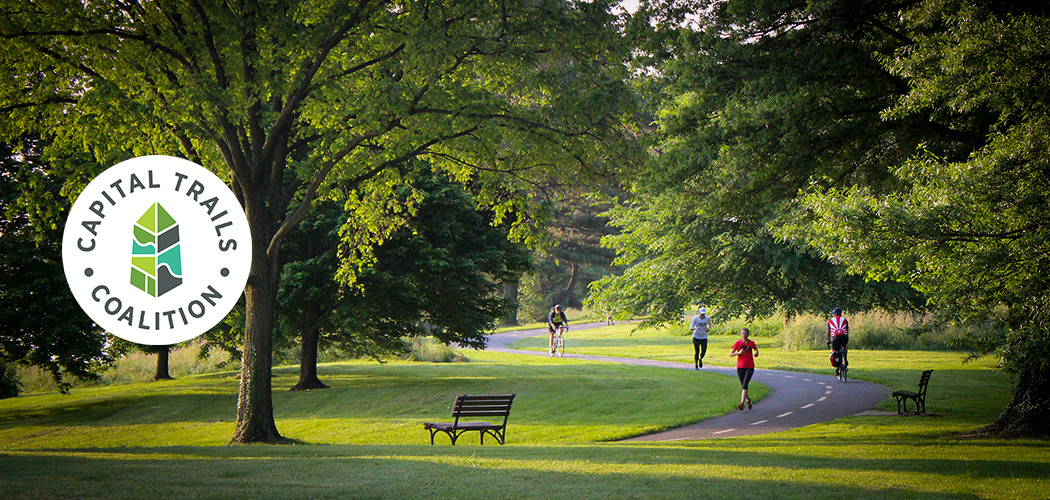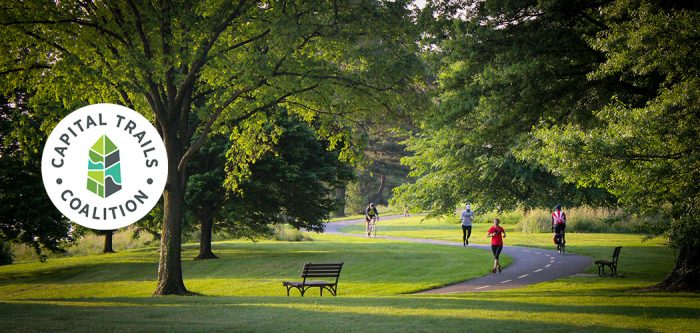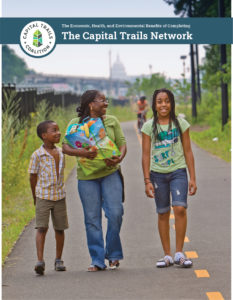
WASHINGTON, DC — The Capital Trails Coalition today released a list of the 40 featured trail projects which comprise the most critical gaps in the network known as the Capital Trails Network which covers Washington DC, Prince George’s County, Montgomery County, Arlington County, Fairfax County and the City of Alexandria.
Currently, the Washington D.C. metropolitan region has 436 miles of existing trails, with 302 miles of planned trails needed to complete the network. The 40 featured projects will go a long way to knit this vast system together and create the world-class network of trails.
These 40 projects are:
- Anacostia River Trail (Arboretum Bridge)
- Anacostia River Trail (all other incomplete segments)
- Anacostia Riverwalk at Buzzard Point
- Arlington Boulevard Trail
- Backlick Run Trail
- Cabin Branch Trail
- Cemetery Wall Trail
- Central Avenue Connector Trail
- Connection Trail for Anacostia River Trail to Marvin Gaye Trail
- Custis Trail Extension/ 1-66 Trail
- Eastern Avenue Trail
- East Capitol Street Bridge Connector
- Fort Circle Parks Trail
- Georgetown Waterfront Connector (Bridge over Rock Creek)
- Key Bridge to Capital Crescent Trail
- Little Paint Branch Trail
- Long Bridge
- Louisiana Avenue Connection
- Memorial Bridge Trail Connections
- Metropolitan Branch Trail
- Montrose Parkway East
- New York Avenue Trail
- North Beauregard Street
- Oxon Run Trail Connection- North
- Oxon Run Trail Connection- South
- Pennsylvania Avenue Sidepath
- Piscataway Creek Trail
- Prince George’s County Connector Trail
- Purple Line Trail
- Rhode Island Avenue Trolley Trail
- Rock Creek Park Trail Rehabilitation
- Shepherd Branch Trail
- South Capitol Street Trail
- Suitland Bog Connector
- Suitland Parkway Trail
- Theodore Roosevelt Bridge to North Meade Street
- VRE Trail
- Washington, Baltimore & Annapolis (WB&A) Trail Bridge over Patuxent River
- Washington, Baltimore & Annapolis (WB&A) Trail Extension along MD 704
- Washington Boulevard Trail
“A well-connected regional trails network promises to help transform public life by linking diverse communities, promoting personal and environmental health, and building sustainable local economies. Completing these 40 projects, including several in DC, will provide the foundation for building out the rest of the Network and finishing all 152 identified gaps,” said Jack Koczela, Chair of the Capital Trails Coalition and Co-Chair of the Mayor’s Recreational Trail Advisory Committee of Washington, DC.
The Capital Trails Coalition used the following methodology to determine the 40 featured projects:
(a) the corresponding governmental jurisdictions deemed at least 23 of these 40 projects as their priorities and (b) each project met a threefold criterion set forth by the Capital Trails Coalition. The development of these criteria was informed by the Coalition’s vision and mission statement, as well as the Coalition’s definition of Equitable Trail Development. The criteria require that the trail intersects the boundary of (a) high-population-density areas with (b) low-income communities of color that are also (c) MWCOG Activity Centers.
Every planned trail within the network must also meet the Coalition’s criteria for network inclusion, which includes specifications for safety, measured width, surface requirements, connections to job centers, schools, and parks among many other requirements.
“The 40 projects identified by the Coalition represent key opportunities to connect the existing trails into a regional network,” said Bryan Barnett-Woods, M-NCPPC transportation planner in Prince George’s County. “Ten of the featured projects are in Prince George’s County and when completed will help bring neighborhoods, activity centers, and recreational destinations closer together. We look forward to a complete network of safe and convenient trails in the region for everyone’s enjoyment.”
The planned trails will close gaps in the regional trail network, connect smaller trails to high-capacity trails, including the Metropolitan Branch Trail, the Mount Vernon Trail and the Capital Crescent Trail, and also connect with larger trails, such as the September 11th National Memorial Trail, the East Coast Greenway, the American Discovery Trail, the C&O Canal Towpath, and the Potomac Heritage National Scenic Trail.
“The Coalition’s efforts to define a regional connected trail system will help us make the case for how our projects will contribute to a larger network,” says Darren Buck, Complete Streets Coordinator at City of Alexandria.
A world-class, seamless trail network will provide safe places for people to exercise; encourage active transportation; save people money on transportation, exercise, and recreation; provide an option for folks who cannot afford other transportation options; help regional jurisdictions meet environmental goals by reducing congestion, decreasing vehicle miles traveled, improving air quality and lowering carbon emissions.
About the Capital Trails Coalition
The Capital Trails Coalition, founded in 2015, seeks to create a world-class network of multi-use trails that are equitably distributed throughout the Washington D.C. metropolitan region. The Capital Trails Network will transform public life by providing healthy, low-stress access to open space and reliable transportation for people of all ages and abilities.
The Capital Trails Coalition is a collaboration of over 60 organization members, including the Rails-to-Trails Conservancy, the Washington Area Bicyclist Association, various business improvement districts and citizen groups. The National Park Service and other government agencies serve as advisory members.
Find the press release here.


